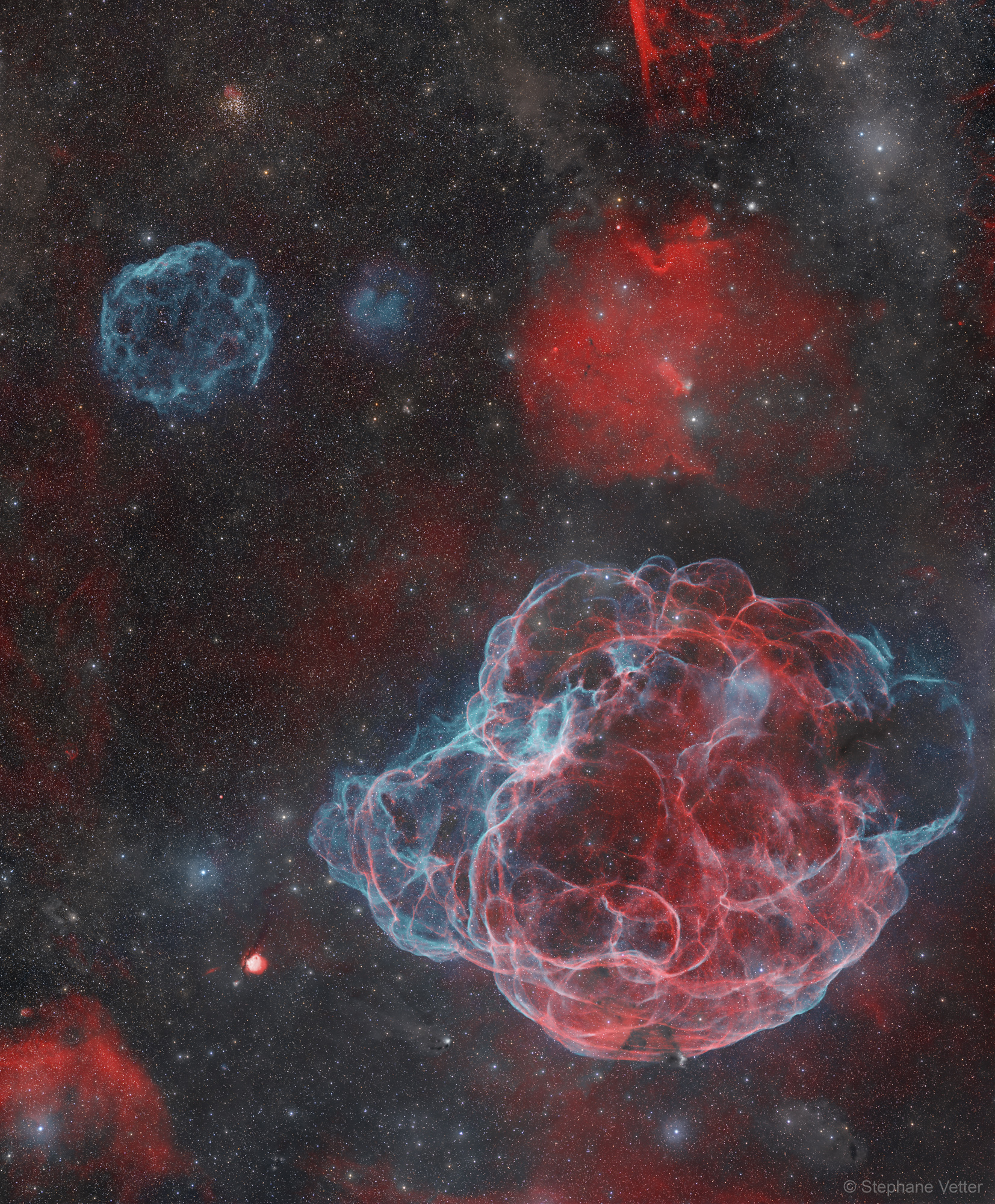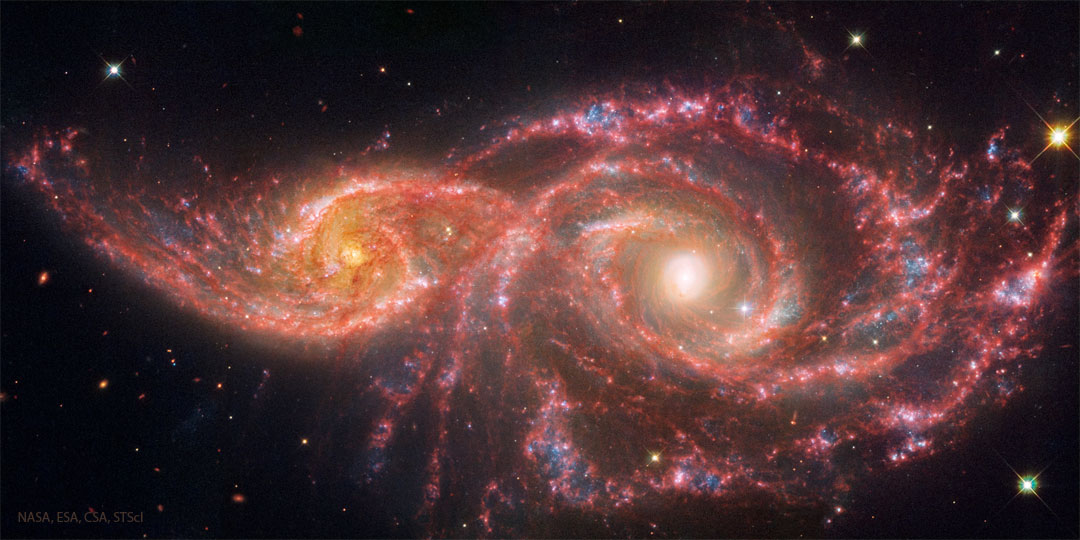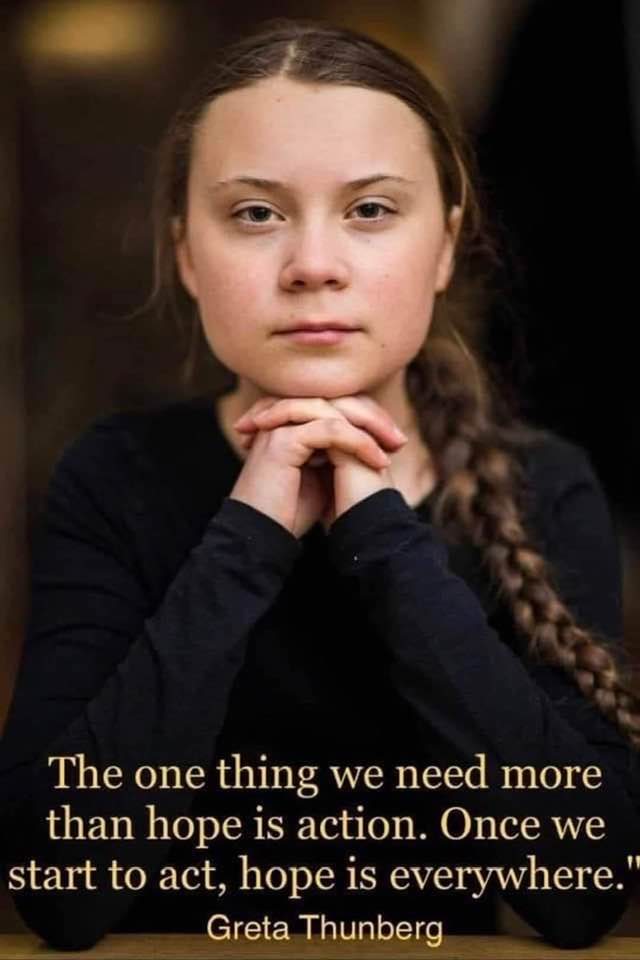Blog
A huge fireball of hot gas shoots out in all directions. When this gas slams into the existing interstellar medium, it heats up so much it glows. Two different supernova remnants (SNRs) are visible in the featured image, taken at the Oukaïmeden Observatory in Morocco. The blue soccer ball-looking nebula toward the upper left is SNR G179.0+02.6, which appears to be the smaller one. This supernova, about 11,000 light years distant, detonated about 50,000 years ago. Although composed mostly of hydrogen gas, the blue light is emitted by a trace amount of oxygen. The seemingly larger SNR, dominating the lower right of the frame, is the Spaghetti Nebula, cataloged as Simeis 147 and sh2-240. This supernova, only about 3,000 light years away, exploded about 40,000 years ago. Comparatively, even though they appear different sizes, both supernova remnants are not only roughly the same age, but about the same size, too.

David Robert Jones (8 January 1947 – 10 January 2016), known professionally as David Bowie was an English singer, songwriter, musician and actor. Regarded as one of the most influential musicians of the 20th century, Bowie was acclaimed by critics and musicians, particularly for his innovative work during the 1970s. His career was marked by reinvention and visual presentation, and his music and stagecraft has had a significant impact on popular music.
Bowie developed an interest in music from an early age. He studied art, music and design before embarking on a professional career as a musician in 1963. He released a string of unsuccessful singles with local bands and a self-titled solo album (1967) before achieving his first top-five entry on the UK singles chart with “Space Oddity” (1969). After a period of experimentation, he re-emerged in 1972 during the glam rock era with the flamboyant and androgynous alter ego Ziggy Stardust. The character was spearheaded by the success of “Starman” and its album The Rise and Fall of Ziggy Stardust and the Spiders from Mars (both 1972), which won him widespread popularity. In 1975, Bowie’s style shifted towards a sound he characterised as “plastic soul“, initially alienating many of his UK fans but garnering his first major US crossover success with the number-one single “Fame” and the album Young Americans (both 1975). In 1976, Bowie starred in the cult film The Man Who Fell to Earth and released Station to Station. In 1977, he again changed direction with the electronic-inflected album Low, the first of three collaborations with Brian Eno that came to be known as the Berlin Trilogy. “Heroes” (1977) and Lodger (1979) followed; each album reached the UK top five and received lasting critical praise.
After uneven commercial success in the late 1970s, Bowie had three number-one hits: the 1980 single “Ashes to Ashes“, its album Scary Monsters (and Super Creeps) and “Under Pressure” (a 1981 collaboration with Queen). He achieved his greatest commercial success in the 1980s with Let’s Dance (1983). Between 1988 and 1992, he fronted the hard rock band Tin Machine before resuming his solo career in 1993. Throughout the 1990s and 2000s, Bowie continued to experiment with musical styles, including industrial and jungle. He also continued acting; his roles included Major Jack Celliers in Merry Christmas, Mr. Lawrence (1983), Jareth the Goblin King in Labyrinth(1986), Phillip Jeffries in Twin Peaks: Fire Walk with Me (1992), Andy Warhol in the biopic Basquiat (1996), and Nikola Tesla in The Prestige (2006), among other film and television appearances and cameos. He ceased touring after 2004 and his last live performance was at a charity event in 2006. He returned from a decade-long recording hiatus in 2013 with The Next Day and remained musically active until his death from liver cancer in 2016. He died two days after both his 69th birthday and the release of his final album, Blackstar.
During his lifetime, his record sales, estimated at over 100 million worldwide, made him one of the best-selling musicians of all time. He is the recipient of numerous accolades, including six Grammy Awards and four Brit Awards. Often dubbed the “chameleon of rock” due to his constant musical reinventions, he was inducted into the Rock and Roll Hall of Fame in 1996. Rolling Stone ranked him among the greatest singers, songwriters and artists of all time. As of 2022, Bowie was the best-selling vinyl artist of the 21st century.
more...Bill Graham (born Wulf Wolodia Grajonca; January 8, 1931 – October 25, 1991) was a German-born American impresario and rock concert promoter.
In the early 1960s, Graham moved to San Francisco, and in 1965, began to manage the San Francisco Mime Troupe. He had teamed up with local Haight Ashbury promoter Chet Helms to organize a benefit concert, then promoted several free concerts. This eventually turned into a profitable full-time career and he assembled a talented staff. Graham had a profound influence around the world, sponsoring the musical renaissance of the 1960s from its epicenter in San Francisco. Chet Helms and then Graham made famous the Fillmore and Winterland Ballroom; these turned out to be a proving grounds for rock bands and acts of the San Francisco Bay area including the Grateful Dead, Jefferson Airplane, and Big Brother and the Holding Company with Janis Joplin, who were first managed, and in some cases developed, by Helms.
more...Singer Jerome “Little Anthony” Gourdine was born on January 8, 1941, to Victoria Stafford and Thomas Elliot Gourdine. He grew up in the Fort Greene Housing Project in Brooklyn, New York, and attended Boys High School. While in high school, Gourdine and his friends created a doo-wop group called, “The Duponts.”
In 1957, Gourdine joined a new group called the, The Chesters, as the lead vocalist. The group recorded, “Tears on My Pillow,” which became an instant success. The Chesters, changed their name to Little Anthony & The Imperials, in 1959, and released their second hit single, “Shimmy, Shimmy, Ko-Ko-Bop,” which sold one million records.
Little Anthony & the Imperials reformed under DCP records in 1964. From 1964 through 1967, Little Anthony & The Imperials achieved success with songs like, “I’m Outside Looking In,” “Goin’ Out of My Head,” and “Hurt So Bad.” They appeared on the “The Ed Sullivan Show,” the “Kraft Music Hall Television Show,” and Dick Clark’s television specials. In 1969, Little Anthony & The Imperials signed with United Artists and recorded several chart singles. Gourdine left the group in 1975 to begin a sixteen year long acting and solo singing career.
Little Anthony & The Imperials performed their first reunion show in 1992, in New York City, New York. Over the years, they have had seventeen pop and twelve R&B chart hits.
Gourdine now resides in Las Vegas, Nevada with his wife, Linda.
Jerome “Little Anthony” Gourdine was interviewed by The HistoryMakers on April 6, 2007.
more...Dave Weckl (born January 8, 1960, in St. Louis, Missouri) is an American jazz fusiondrummer and the leader of the Dave Weckl Band. He was inducted into the Modern Drummer Hall of Fame in 2000.
Weckl started playing his first set of drums at age 8 in his spare room along with records. He later played in the living room, sometimes with his father on piano.Weckl studied at the University of Bridgeport. Starting out on the New York fusion scene in the early 1980s, Weckl soon began working with artists such as Paul Simon, George Benson, Michel Camilo, Robert Plant, and Anthony Jackson.
He was with the Chick Corea Elektric Band from 1985 to 1991. During this time he performed on many albums and also appeared with Corea’s Akoustic Band. He said he “augmented his work with Corea by continuing his session work and appearing often with the GRP All-Star Big Band“. Weckl has released a series of instructional videotapes. His first recording as leader was in 1990 – Master Plan, for GRP. This was followed by Heads Up in 1992, and Hard-Wired in 1994. Later on, Weckl recorded and toured with guitarist Mike Stern.
more...Elvis Aaron Presley (January 8, 1935 – August 16, 1977), known mononymously as Elvis, was an American singer and actor. Known as the “King of Rock and Roll“, he is regarded as one of the most significant cultural figures of the 20th century. Presley’s energized performances and interpretations of songs, and sexually provocativeperformance style, combined with a singularly potent mix of influences across color lines during a transformative era in race relations, brought both great success and initial controversy.
Presley was born in Tupelo, Mississippi; his family moved to Memphis, Tennessee when he was 13. His music career began there in 1954, at Sun Records with producer Sam Phillips, who wanted to bring the sound of African-American music to a wider audience. Presley, on guitar and accompanied by lead guitarist Scotty Moore and bassist Bill Black, was a pioneer of rockabilly, an uptempo, backbeat-driven fusion of country musicand rhythm and blues. In 1955, drummer D. J. Fontana joined to complete the lineup of Presley’s classic quartet and RCA Victor acquired his contract in a deal arranged by Colonel Tom Parker, who managed him for the rest of his career. Presley’s first RCA Victor single, “Heartbreak Hotel“, was released in January 1956 and became a number-one hit in the US. Within a year, RCA Victor would sell ten million Presley singles. With a series of successful television appearances and chart-topping records, Presley became the leading figure of the newly popular rock and roll; though his performative style and promotion of the then-marginalized sound of African Americans led to him being widely considered a threat to the moral well-being of white American youth.
In November 1956, Presley made his film debut in Love Me Tender. Drafted into military service in 1958, he relaunched his recording career two years later with some of his most commercially successful work. Presley held few concerts, and guided by Parker, proceeded to devote much of the 1960s to making Hollywood films and soundtrack albums, most of them critically derided. Some of Presley’s most famous films included Jailhouse Rock (1957), Blue Hawaii (1961), and Viva Las Vegas (1964). In 1968, he returned to the stage in the acclaimed NBC television comeback special Elvis, which led to an extended Las Vegas concert residency and a string of highly profitable tours. In 1973, Presley gave the first concert by a solo artist to be broadcast around the world, Aloha from Hawaii. Years of prescription drug abuse and unhealthy eating severely compromised his health, and Presley died unexpectedly in August 1977 at his Graceland estate at the age of 42.
Presley is one of the best-selling music artists of all time, with sale estimates ranging from 500 million records to over a billion worldwide. He was commercially successful in many genres, including pop, country, rock and roll, rockabilly, rhythm and blues, adult contemporary, and gospel. He won three Grammy Awards, received the Grammy Lifetime Achievement Award at age 36, and has been inducted into multiple music halls of fame. He holds several records, including the most RIAA-certified gold and platinum albums, the most albums charted on the Billboard 200, the most number-one albums by a solo artist on the UK Albums Chart, and the most number-one singles by any act on the UK Singles Chart. In 2018, Presley was posthumously awarded the Presidential Medal of Freedom beating the other nominees.
more...Hudson Whittaker (born Hudson Woodbridge; January 8, 1903 – March 19, 1981 Smithville, GA), known as Tampa Red, was an American Chicago blues musician.
His distinctive single-string slide guitar style, songwriting and bottleneck technique influenced other Chicago blues guitarists such as Big Bill Broonzy, Robert Nighthawk, Muddy Waters, and Elmore James. In a career spanning over 30 years, he also recorded pop, R&B and hokum songs. His best-known recordings include “Anna Lou Blues”, “Black Angel Blues“, “Crying Won’t Help You”, “It Hurts Me Too“, and “Love Her with a Feeling“.
more...Earl Wilberforce “Wire” Lindo (7 January 1953 – 4 September 2017), sometimes referred to as Wya, was a Jamaican reggae musician. He was a member of Bob Marley and the Wailers and collaborated with numerous reggae artists including Burning Spear.
In 1973, he was invited to join The Wailers on a US tour, going on to play on Burnin’. He left the Wailers in 1974 to join Taj Mahal‘s band.
Lindo can be heard on an album credited to the Impact All-Stars. Released in 1975, the album is a collection of dub tracks recorded at Randy’s Studio 17. On his return to Jamaica he played on recordings by Big Youth, Culture, I Roy, and Al Brown, and had some success with solo singles “No Soul Today” and “Who Done It”. In 1978 he rejoined the Wailers, playing on Babylon by Bus, Survival, and Uprising.
more...Billions of years from now, only one of these two galaxies will remain. Until then, spiral galaxies NGC 2207 and IC 2163 will slowly pull each other apart, creating tides of matter, sheets of shocked gas, lanes of dark dust, bursts of star formation, and streams of cast-away stars. The featured image in scientifically assigned colors is a composite of Hubble exposures in visible light and Webb exposures in infrared light. Astronomers predict that NGC 2207, the larger galaxy on the right, will eventually incorporate IC 2163, the smaller galaxy on the left. In the most recent encounter that about peaked 40 million years ago, the smaller galaxy is swinging around counter-clockwise and is now slightly behind the larger galaxy. The space between stars is so vast that when galaxies collide, the stars in them usually do not collide. 110mly

Kenneth Clark Loggins (born January 7, 1948) is an American singer, songwriter, and guitarist. His early songs were recorded with the Nitty Gritty Dirt Band in 1970,which led to seven albums recorded with Jim Messina as Loggins and Messina from 1972 to 1977. His early soundtrack contributions date back to A Star Is Born in 1976, and he is known as the “King of the Movie Soundtrack“. As a solo artist, Loggins experienced a string of soundtrack successes, including an Academy Award nomination for “Footloose” in 1985. Finally Home was released in 2013, shortly after Loggins formed the group Blue Sky Riders with Gary Burr and Georgia Middleman. He won a Daytime Emmy Award, two Grammy Awards and was nominated for an Academy Award, a Tony Award and a Golden Globe Award.
more...Eldee Young (January 7, 1936 – February 12, 2007) was a jazz double-bass and cello player who performed in the cool jazz, post bop and rhythm and blues mediums.
Born in 1936 in Chicago, Illinois, Young started playing upright bass at the age of 13. He was helped by his eldest brother who played guitar. He joined the Ramsey Lewis Trio in 1955. After a decade together he split along with bandmate, Isaac “Red” Holt to form the Young-Holt Trio. They changed their name to Young-Holt Unlimited in 1968. After they split in 1974, Young continued playing, mainly with small groups in Chicago.
He also played with pianist Jeremy Monteiro for more than 20 years. Young also appeared on the albums of James Moody and Eden Atwood, among others. Young died in Bangkok, Thailand, from a heart attack at age 71.
more...Bobo Jenkins (January 7, 1916 – August 14, 1984 Forkland, AL) was an American Detroit bluesand electric blues guitarist, singer and songwriter. He also built and set up his own recording studio and record label in Detroit. Jenkins is best known for his recordingsof “Democrat Blues” and “Tell Me Where You Stayed Last Night”.
more...Henry James “Red” Allen Jr. (January 7, 1908 – April 17, 1967) was an American jazztrumpeter and vocalist whose playing has been claimed by Joachim-Ernst Berendt and others as the first to fully incorporate the innovations of Louis Armstrong. Allen’s career began in Sidney Desvigne‘s Southern Syncopators. He was playing professionally by 1924 with the Excelsior Brass Band and the jazz dance bands of Sam Morgan, George Lewis and John Casimir. After playing on riverboats on the Mississippi River, he went to Chicago in 1927 to join King Oliver‘s band. Around this time he made recordings on the side in the band of Clarence Williams.
more...
Luciano Pozo González (January 7, 1915 – December 3, 1948), known professionally as Chano Pozo, was a Cuban jazz percussionist, singer, dancer, and composer. Despite only living to the age of 33, he played a major role in the founding of Latin jazz. He co-wrote some of Dizzy Gillespie‘s Latin-flavored compositions, such as “Manteca” and “Tin Tin Deo“, and was the first Latin percussionist in Gillespie’s band. According to Rebeca Mauleón, “Few percussionists have played as integral a role in shaping Latin music as Luciano ‘Chano’ Pozo González”.
Chano Pozo was shot and killed on December 2, 1948, in the El Rio Bar at 111th Street and Lenox Avenue in Harlem. The El Rio Bar no longer exists — even the small triangular block where it was located has been removed. Pozo’s killer was a local bookie, marijuana dealer, and fellow Cuban named Eusebio “Cabito” (Little Corporal) Muñoz. Pozo is buried in the Colón Cemetery, Havana.
more...More Posts
- The Cosmos with NGC 6872 & IC 4970
- Paul McCartney Day
- William Hooker Day
- Rudy Rutherford Day
- World Fusion with Manika Kaur
- Daily Roots with the Congos
- Happy Fathers Day 2018
- The Cosmos with RCW 108
- Chuck Rainey Day
- Sing Miller Day
- World Music with Corvus Corax
- Daily Roots with ITSJAHMIEL
- The Cosmos with NGC 3372
- Lucky Thompson Day
- World Music with Sherrifo Konteh
- Daily Roots with Culture
- The Cosmos with NGC 3190
- Jaki Byard Day
- Erroll Garner Day

